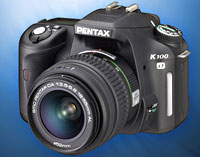 Things are heating up in the entry-level/enthusiast end of the photography market, with Pentax announcing two new new dSLR cameras offering 6.1 effective megapixels.
Things are heating up in the entry-level/enthusiast end of the photography market, with Pentax announcing two new new dSLR cameras offering 6.1 effective megapixels.
The Pentax K100 and K110D cameras both offer high precision 11-point wide frame AF, ISO sensitivity from 200 to 3200 ISO, a large 2.5-inch LCD screen and a shutter speed extending from 30 secs to a superfast 1/4000 sec
The cameras are compatible with most of the huge selection of existing Pentax lenses, including PENTAX K-, KA-, KAF- and KAF2-mount lenses; screw-mount lenses (with an adapter); and 645- are 67-system lenses (with an adapter) – although there may be limited functionality with some older lenses.
K100D : non shake, non rattle and non roll
Entering a market already dominated by excellent low-price models by Nikon and Canon, Pentax are hoping that the anti-shake widget in the K100D – which effectively offers a two-stop advantage – will get punters waving their wads in their direction
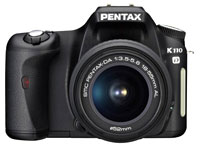 It’s Pentax’s first DSLR to feature a CCD-shift Shake Reduction system – and works by oscillating the CCD image sensor vertically and horizontally at high speed using magnetic force, while adjusting the speed of oscillation in proportion to the amount of camera shake detected by a built-in sensor (err, got that?).
It’s Pentax’s first DSLR to feature a CCD-shift Shake Reduction system – and works by oscillating the CCD image sensor vertically and horizontally at high speed using magnetic force, while adjusting the speed of oscillation in proportion to the amount of camera shake detected by a built-in sensor (err, got that?).
K110D – cheap’n’cheerful
The entry-level digital K110D is exactly the same as the K100D but comes without the Shake Reduction.
Both cameras come with Pentax’s smarty-pants Auto Picture Mode for point’n’shooters. This automatically selects one of the five Picture modes – including Portrait, Landscape and Macro – by calculating various photographic factors to assure top notch results.
There’s also the usual selection of scene modes including Night Scene, Surf & Snow, Text, Sunset, Kids and Museum
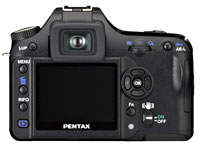 The Pentax K100D (with smc 18-55mm lens) will be shunting off the shelves for around $700, while the K110D will ship with the same lens for a competitive $600.
The Pentax K100D (with smc 18-55mm lens) will be shunting off the shelves for around $700, while the K110D will ship with the same lens for a competitive $600.
Pentax K100D/ K110D specifications
Sensor 6.1 million effective pixels
Image sizes 3008 x 2000, 3008 x 2008 (RAW), 2400 x 1600, 1536 x 1024,
File formats JPEG (8-bit), RAW (12-bit), DCF, DPOF, PRINT Image Matching lll
Lens Mount Pentax KAF bayonet mount
Focus TTL Phase-matching 11-point wide autofocus system (SAFOX Vlll), AF Single, Manual, AF Continuous
Image Stabilization Shake Reduction (SR) system (K100 only)
AF assist lamp Yes (by built-in flash)
Metering TTL open-aperture 16-segment (coupled with lens and AF information), Multi-segment, Center-weighted, Spot
ISO sensitivity Auto, ISO 200, ISO 400, ISO 800, ISO 1600, ISO 3200
Exposure compensation +/- 2EV, 1/2EV or 1/3 EV steps
Exposure bracketing 3 frames within range of +/-0.5EV, +/-1.0EV, +/-1.5EV (0.5EV steps) or +/-0.3EV, +/-0.7EV, +/-1.0EV (0.3EV steps)
Shutter Electronically controlled vertical-run focal plane shutter
Shuttter speed 1/4000 – 30 sec
Modes Auto Picture mode, Picture mode, Scene, Program AE, Shutter Priority AE, Aperture Priority AE, Metered Manual, Bulb
Picture modes Portrait, Landscape, Macro, Action, Night Scene Portrait, Standard Flash Off
White balance Auto, Daylight, Shade, Cloudy, Tungsten Light, Fluorescent Light (W, D, N), Flash, Manual
Continuous shooting Approx 2.8 fps: JPEG(up to 5fps), RAW(up to 3fps)
Flash Built-in retractable P-TTL pop-up, Guide number 15.6
Viewfinder Fixed molded penta-mirror type, 96% field of view
LCD monitor 2.5-inch low temperature polysilicon TFT, 210,000 pixels
Connectivity USB 2.0 Hi-speed
Storage SD card
Power 4 x AA batteries(Alkaline, Lithium, rechargeable Ni-MH), 2 x CR-V3 llithium batteries, Optional AC adapter
Weight (no batt) 560 g (19.8 oz) 485 g
Dimensions 129.5 x 92.5 x 70 mm (5.1 x 3.6 x 2.8 in)
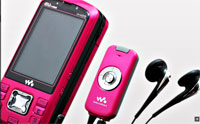 Sony Ericsson has announced its first Walkman phone for Japan today and it looks like a beaut.
Sony Ericsson has announced its first Walkman phone for Japan today and it looks like a beaut. True to its Walkman heritage, the slide-out phone has a smorgasbord of built-in dedicated music controls, including a natty new mechanical navigation wotsit bolted on to the bottom of the phone.
True to its Walkman heritage, the slide-out phone has a smorgasbord of built-in dedicated music controls, including a natty new mechanical navigation wotsit bolted on to the bottom of the phone.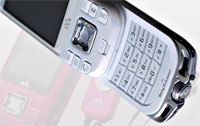 There’s been no firm announcement of the retail price yet, although it’s hotly rumoured to be around the $180 mark, and no announcement of a UK release yet, natch.
There’s been no firm announcement of the retail price yet, although it’s hotly rumoured to be around the $180 mark, and no announcement of a UK release yet, natch.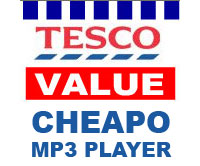 Sitting right next to the baked beans and cornflakes at a Tescos near you soon should be Tesco’s new range of cheapo MP3 players.
Sitting right next to the baked beans and cornflakes at a Tescos near you soon should be Tesco’s new range of cheapo MP3 players.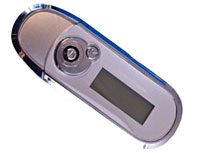 The interface is bog standard but straightforward – there’s not much to get confused about here – and the player connects to desktops via a USB interface.
The interface is bog standard but straightforward – there’s not much to get confused about here – and the player connects to desktops via a USB interface. Tesco are no stranger to this MP3 thing, launching an
Tesco are no stranger to this MP3 thing, launching an 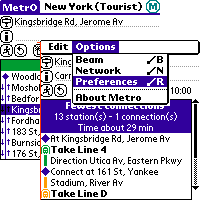 For globe trotters, city slickers, urban commuters and spoddy transport types, the freeware Metro looks to be a very useful application.
For globe trotters, city slickers, urban commuters and spoddy transport types, the freeware Metro looks to be a very useful application. Using Metro
Using Metro Using the program’s simple interface, you can also get Metro to display station details, stops between the stations on your journey and even associate contacts with stations.
Using the program’s simple interface, you can also get Metro to display station details, stops between the stations on your journey and even associate contacts with stations.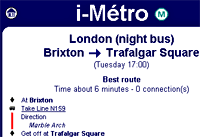 Conclusion
Conclusion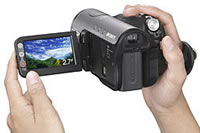 The HC3 has a tough act to follow – its own big brother, the HC1. Last year’s HC1 brought High Definition recording within the budget of almost any home movie-maker for the first time, and did it with assurance and style. Luckily, Sony hasn’t rested on its laurels, and the HC3 feels very much like a replacement for the HC1 rather than a mere upgrade.
The HC3 has a tough act to follow – its own big brother, the HC1. Last year’s HC1 brought High Definition recording within the budget of almost any home movie-maker for the first time, and did it with assurance and style. Luckily, Sony hasn’t rested on its laurels, and the HC3 feels very much like a replacement for the HC1 rather than a mere upgrade. Changes to the imaging pipeline have enabled Sony to offer a couple of new features in the HC3. The first is the ability to capture up to three 2MP still photos while filming (the images buffer until you stop recording). The second is Smooth Slow capture, where the capture rate increases from 50 to 200 fields per second for three seconds. Audio recording and the Super SteadyShot audio are disabled while you shoot. You can then play back this footage at a normal frame rate, giving 12 seconds of smooth slow motion footage.
Changes to the imaging pipeline have enabled Sony to offer a couple of new features in the HC3. The first is the ability to capture up to three 2MP still photos while filming (the images buffer until you stop recording). The second is Smooth Slow capture, where the capture rate increases from 50 to 200 fields per second for three seconds. Audio recording and the Super SteadyShot audio are disabled while you shoot. You can then play back this footage at a normal frame rate, giving 12 seconds of smooth slow motion footage.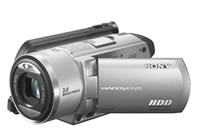 Just when you thought Sony couldn’t add any more formats to its camcorder range (the electronics giant already carries MiniDV, MicroMV, Hi8, Digital 8 and DVD models), along comes a new hard disc camcorder (the DCR-SR90) and a re-vamped Hi Def pro-sumer shooter (HDR-HC3). We caught up with both at an exclusive hands- on presentation in London. Details of the Sony HDR-HC3 will follow tomorrow.
Just when you thought Sony couldn’t add any more formats to its camcorder range (the electronics giant already carries MiniDV, MicroMV, Hi8, Digital 8 and DVD models), along comes a new hard disc camcorder (the DCR-SR90) and a re-vamped Hi Def pro-sumer shooter (HDR-HC3). We caught up with both at an exclusive hands- on presentation in London. Details of the Sony HDR-HC3 will follow tomorrow. The interface is generally very good, with a 2.7-inch folding touchscreen ported straight from Sony’s MiniDV range, giving access to a good range of creative features, including true 16:9 recording.
The interface is generally very good, with a 2.7-inch folding touchscreen ported straight from Sony’s MiniDV range, giving access to a good range of creative features, including true 16:9 recording.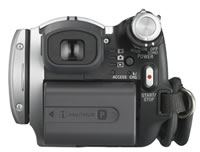 Playback features include basic editing tools that let you move scenes around but not cut or join them. Ease of use is emphasized with a One Touch DVD burn button for Windows computers with a DVD writer – just plug in via USB, slip in a disc and away you go.
Playback features include basic editing tools that let you move scenes around but not cut or join them. Ease of use is emphasized with a One Touch DVD burn button for Windows computers with a DVD writer – just plug in via USB, slip in a disc and away you go.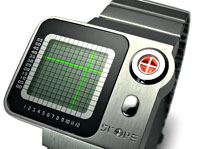 Without doubt quite the silliest timepiece we’ve seen for a long time, this new watch by Japanese manufacturers Scompe manages to turn the mundane task of checking the time into some sort of sci-fi adventure.
Without doubt quite the silliest timepiece we’ve seen for a long time, this new watch by Japanese manufacturers Scompe manages to turn the mundane task of checking the time into some sort of sci-fi adventure.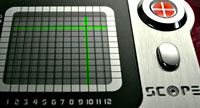 Managing to complicate the simple task of reading the time, users must read off the vertical line for the hour and the horizontal line for the minutes, checking their values against the tiny onscreen numbers.
Managing to complicate the simple task of reading the time, users must read off the vertical line for the hour and the horizontal line for the minutes, checking their values against the tiny onscreen numbers.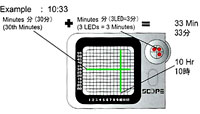 Powered by 2 lithium cells, the SCOPE watch is quite a chunky beast, measuring 45mm x 33mm x 11mm.
Powered by 2 lithium cells, the SCOPE watch is quite a chunky beast, measuring 45mm x 33mm x 11mm.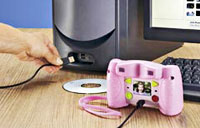 Back in our day, we were lucky if we got a lump of mud as a toy (Luxury! – editor), but kids today are spoilt rotten with an endless succession of frivolous gadgets demanding an unwelcome draining of parents’ wallets.
Back in our day, we were lucky if we got a lump of mud as a toy (Luxury! – editor), but kids today are spoilt rotten with an endless succession of frivolous gadgets demanding an unwelcome draining of parents’ wallets. Fisher Price’s website doesn’t offer any details about camera resolution, but we figure it’s going to be pretty crappy.
Fisher Price’s website doesn’t offer any details about camera resolution, but we figure it’s going to be pretty crappy. The circular player features big buttons and an LCD screen with icons to let kids pick their own choons and be a junior DJ Selectaaaaaa!
The circular player features big buttons and an LCD screen with icons to let kids pick their own choons and be a junior DJ Selectaaaaaa! Sony has whipped out its first laptop equipped with a next-generation Blu-ray optical disk drive, saying that it will be available in Japan next month.
Sony has whipped out its first laptop equipped with a next-generation Blu-ray optical disk drive, saying that it will be available in Japan next month. The AR-Series will also come with a HDMI (High Definition Multimedia Interface) output for hooking up the lappie to a HD-ready TV or Full HD desktop display.
The AR-Series will also come with a HDMI (High Definition Multimedia Interface) output for hooking up the lappie to a HD-ready TV or Full HD desktop display. Powered by Intel Core Solo U1400 (1.2 Ghz)/U1300 (1.06 Ghz) the pint-sized PC will sport an Intel 945GMS Express chipset, 512MB RAM, 20/30 GB hard drive and 69 key QWERTY keyboard.
Powered by Intel Core Solo U1400 (1.2 Ghz)/U1300 (1.06 Ghz) the pint-sized PC will sport an Intel 945GMS Express chipset, 512MB RAM, 20/30 GB hard drive and 69 key QWERTY keyboard. Nordic mobile goliaths Nokia have unveiled an upgrade for their Nokia 770 Internet Tablet which gives the chunky device VoIP and instant messaging capabilities through Google Talk.
Nordic mobile goliaths Nokia have unveiled an upgrade for their Nokia 770 Internet Tablet which gives the chunky device VoIP and instant messaging capabilities through Google Talk. Sales weren’t too hot though, but Nokia reckon that by bolting on VoIP phone capabilities they can turbo charge unit-shifting, with Virtanen insisting that internet telephony is “the key for us to reach higher sales volumes.”
Sales weren’t too hot though, but Nokia reckon that by bolting on VoIP phone capabilities they can turbo charge unit-shifting, with Virtanen insisting that internet telephony is “the key for us to reach higher sales volumes.” The updated OS also boasts enhanced text typing with full-screen finger keyboard, improved memory performance and a ‘refreshed’ look (did they throw a bucket of water at it, or something?).
The updated OS also boasts enhanced text typing with full-screen finger keyboard, improved memory performance and a ‘refreshed’ look (did they throw a bucket of water at it, or something?).